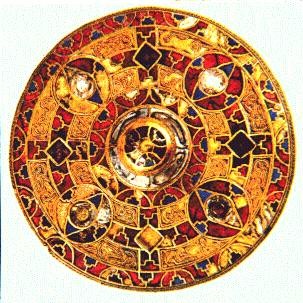
- Quick Guide:
- Shakespeare crasheth the party
- Exercises and Activities
In your textbook you learned that the following endings are applied to most verbs in the present tense. The parentheses around the e and t in the singular column mean that the endings are not always applied to the stem of the verb; these are special verbs for which you will have to learn other endings.
| Singular | Ending | Plural | Ending |
|---|---|---|---|
| ich | (e) | wir | en |
| du | st | ihr | t |
| er/sie/es | (t) | sie (pl.), Sie | en |
Let's start with a simple verb, spielen. We take the stem "spiel" and then apply our endings.
| Singular | Form | Plural | Form |
|---|---|---|---|
| ich | spiele | wir | spielen |
| du | spielst | ihr | spielt |
| er/sie/es | spielt | sie (pl.), Sie | spielen |
How, then, does Old English even fit into the pattern? You'll be glad to know that the endings in the singular are identical to those in German, even though the stem may differ slightly. The following tables provide the conjugations for two verbs in Old English: fremman (to do) and singan (to sing). The endings that are the same as in German are bold-faced.
| Singular | Form | Plural | Form |
|---|---|---|---|
| ic | fremme | wē | fremmaþ |
| þū | fremmest | gē | fremmaþ |
| hē/hīo | fremmeþ | hī | fremmaþ |
| Singular | Form | Plural | Form |
|---|---|---|---|
| ic | singe | wē | singaþ |
| þū | singest | gē | singaþ |
| hē/hīo | singeþ | hī | singaþ |
The -e that applies to the ich-form in German also applies to the ic-form in Old English and the -st ending is common to the second person singular form of the verb in both languages.
The verb ending for the er-form in German and for the hē-form in Old English may not seem to jive at first, but remember that German originally had the "th"-sound but eventually lost it. This sound was replaced by /d/ in most cases, but for verb endings it was replaced by /t/.
Shakespeare crasheth the party
Those of you who have seen Shakepeare have seen some unusual-looking verb forms, such as "thou speakest" and "he maketh", among others. These endings turn out to be the same endings that were found over 600 years earlier; only the þ found in such forms as fremmeþ has changed its written form to the more familiar th.
Additionally, two present tense forms of haben drop the middle consonant, namely "du hast" and "er hat". Shakepeare's forms of "to have" also drop the v: "thou hast" and "er hath".
(Information on Old English from Mitchell and Robinson 43, 46)
Exercises and Activities
(Exercises open in a new window) Old English and Modern High German Present Tense EndingsShakespearean and Modern High German Present Tense Endings
Present Tense Verbs (1)
Present Tense Verbs (2)
Previous: Sounds and Cognates || Next: Stem Changers
![]()
![]()